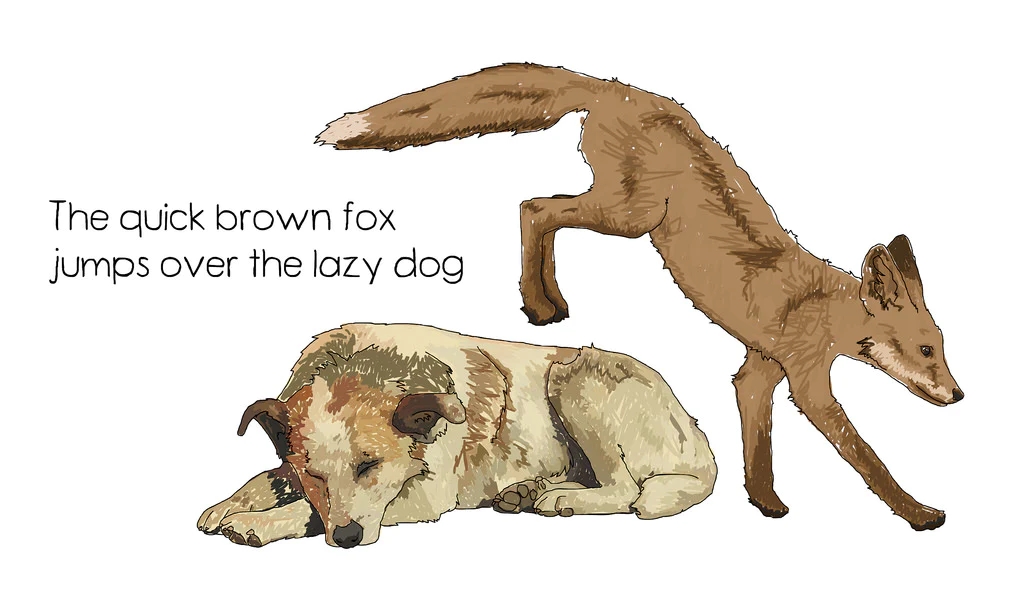 Quick Brown Fox Story
Quick Brown Fox StoryQuick Brown Foxes, Lazy Dogs, and a Properly Produced Story
If you attended school taught primarily in English, you’ve likely heard this sentence before: The quick brown fox jumps over the lazy dog. This sentence is famous for the story behind it, but that story is not about the fox or the dog or the dynamics between wild and domesticated animals. The story is about the remarkable flexibility and creativity with which you can wield the English language, illustrated by the sentence’s unique usage of every letter in the English alphabet. This makes it a pangram, and its usage dates back to the 1800s when Western Union and other communications companies deployed it for testing equipment performance. This particular pangram has survived the test of time because it is distinct and easily memorable for its target audience, the bigger picture is plain to see, and it is both portable and frequently repeated. That same storytelling strategy is the key to good public relations. Studying it can help your brand(s) create more compelling campaigns that move customers to action and improve brand loyalty.
The Story Must Appear Distinct and Easily Memorable to your Target Audience
Caster’s client roster is composed of about two dozen companies from across a wide range of sectors in the broader technology industry. While each of these companies is unique in its own way, the truth is countless other companies are competing for the same customers. At a high level, their stories often appear similar. The same is true with pangrams, as you can see by the examples below:
- “The five boxing wizards jump quickly.”
- “Pack my box with five dozen liquor jugs.”
- “Sphinx of black quartz, judge my vow.”
- “Glib jocks quiz nymph to vex dwarf.”
Each of the above pangrams still satisfies the same condition as the one about the fox and dog – they are complete sentences that use every letter in the English alphabet. Why is the fox and dog pangram stickier in your mind then? The answer is not because it uses complex words or salacious concepts: its distinction is its accessibility. While boxing wizards and commercial quantities of liquor might make for a good Saturday night, it is much easier to conjure a mental image of a quick brown fox or a lazy dog, both at once and over time. This is particularly true for the target audience, usually children in grade school. The “core competency” of the pangram is the same as its alternatives, but it is better built to fit the audience’s particular need for familiarity and ease of recall.

Boxing Wizards
That’s how we try to position our client companies as well: “Though others exist who can address this customer need, only Company XYZ does so in a way that meets this set of key customer criteria.”
The Bigger Picture is Plain to See
In addition to the elegant accessibility and memorability of the fox and dog pangram, what makes the sentence sticky in our minds is that the greater implication is easily observed and the leap to it is logical. English teachers are not asking their young students to reckon with the concept of time travel – they simply aim to demonstrate the versatility and creativity with which you can wield the English language. Students do not need to puzzle out the meaning of the sentence either; every letter is simply laid out before them. The presentation is simple, the concept is clear, and the connection between the two is very evident.
The Caster crew embraces this storytelling style with our clients, always trying to tie our clients’ brands to the tangible and emotional benefits their solutions provide. An example of a client we’ve done this for is Airzone, which builds a product that allows smart thermostats to communicate fully with HVAC systems for the first time, unlocking energy efficiency and functionality currently lost in translation. Our messaging for the company and its product communicates that consumers are costing themselves money because their devices can’t communicate. We then establish that Airzone opens up that method of communication. The messaging is simple, the concept is clear, and the association between Airzone and energy savings should be strong.
The Story’s Lesson is Portable and Repeated Frequently
The English language is flexible and versatile; this concept remains true when separated from the pangrams used to communicate that concept. You can take it with you and apply it elsewhere. The same is true for the communication issues between smart thermostats and HVAC systems. Even if you don’t remember the name Airzone specifically, you will remember the concept driving their business. Once you’re aware of the problem Airzone solves, you’ll start seeing it elsewhere, making you think of Airzone again. The more portable the moral of the story, the stickier it will be.
Portability leads to repetition. The more places you can bring a concept, the more places you’ll see it or apply it. The more places you see or apply something, the more likely you are to remember it. The number of touchpoints required to remember something varies from person to person, but more is almost always better. When drafting content for our clients, we try to inject company messaging into each item. This happens in the first sentence of every press release, where the client’s name is followed by a descriptor – “Airzone, a global leader in IoT-HVAC compatibility” – but it also happens in thought leadership articles, case studies, and product features.
If I’ve successfully followed my own advice, you should know by now how to get a story to survive the test of time. The keys to making your clients as memorable as a quick brown fox are to craft a distinct and memorable message that fits your target audience, to make the bigger picture plain to see and portable, and to repeat it as often as you can.
